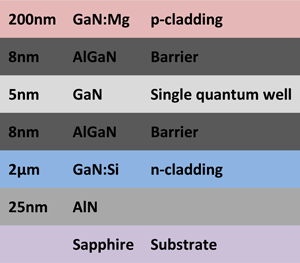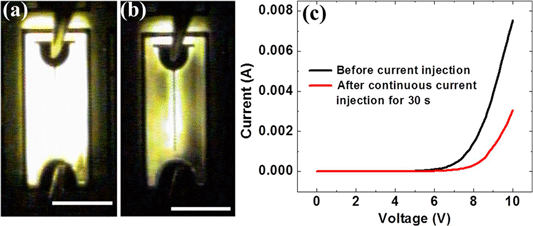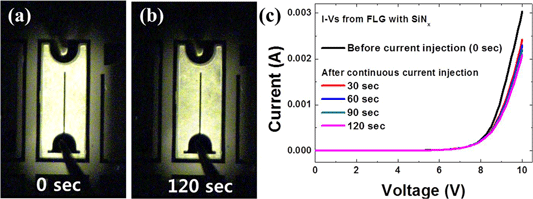Silicon nitride protection for graphene electrodes in UV-LEDs
Korea University, US Naval Research Laboratory and University of Florida have improved the reliability of graphene electrodes in ultraviolet light-emitting diodes (UV-LEDs) through the application of 20nm silicon nitride (SiN).
Graphene electrodes have recently been proposed as UV-transparent conducting layers (TCLs) for spreading current uniformly across LED devices. Uniform current enhances the performance of nitride semiconductor LEDs. Other transparent conducting materials such as indium tin oxide (ITO) begin to cut-off in the UV region. Also, indium is an expensive material. However, the use of graphene in LEDs is hampered by oxidation of the material at high temperature.

The epitaxial material for the UV-LEDs (Figure 1) was grown on sapphire using metal-organic chemical vapor deposition (MOCVD). The few-layer graphene (FLG) was grown on copper foil using methane and hydrogen gas at 1000°C. The graphene was covered with poly(methyl methacrylate) (PMMA) to allow etching away of the copper in sulfuric acid solution for 6 hours. The graphene was then transferred onto the epitaxial material before standard processing into mesa-type LEDs with metal electodes.
Figure 1: Epitaxial material for UV-LEDs. AlN deposited at 680°C, 50Torr; other layers at 1025°C, 150Torr.
These devices when subjected to 10V bias for 30 seconds suffered serious degradation in performance both in terms of light emission and electrically (Figure 2). Where before the biasing the LEDs showed bright emission from across the chip, afterwards light came only from near the metal electrodes. The current-voltage curves also showed reduced current from the device stressing.

Figure 2: Microscopic electroluminescence images of UV-LED without SiNx layer (a) before and (b) after applying continuous current injection for 30s at a forward bias of 10 V. (c) Current versus voltage (I-V) characteristics from UV-LED without SiNx layer.
A pulsed bias condition (5% duty cycle) of 10V for 30 seconds was also applied to fresh devices to remove self-heating effects. Although the effect was not as severe, partial degradation of the performance was also seen.
The degradation was attributed to oxidation reducing the thickness of the FLG layer. It was estimated that the FLG consisted of four layers before the continuous bias, reducing to two layers after the electrical/thermal stress. The oxidation is thought to occur more readily at edges and defect sites. In the continuous bias test, the reduction in light emission proceeded from the outer edges of the graphene.
To avoid these effects, the researchers applied 20nm of silicon nitride to the devices using a Unaxis plasma-enhanced chemical vapor deposition (PECVD) system. The aim was to protect the FLG from attack by oxygen. Silicon nitride has an intermediate refractive index of ~2.1 between the values for GaN (~2.5) and air (1). Also, SiN has high transmittance of UV.
The SiN-passivated LEDs suffered much less degradation under 10V continuous bias (Figure 3). Further, the time for current to fall to half the initial value was 3 to 6 minutes.

Figure 3: Microscopic electroluminescence images of UV-LED with SiNx layer (a) before and (b) after applying continuous current injection for 120s at a forward bias of 10V. (c) I-V characteristics from UV-LED with SiNx protective layer.
The researchers comment: "Since this SiNx-based passivation technique is compatible with current manufacturing process, it will be convenient and effective for improving the reliability of the graphene-based electronic/optoelectronic devices."





